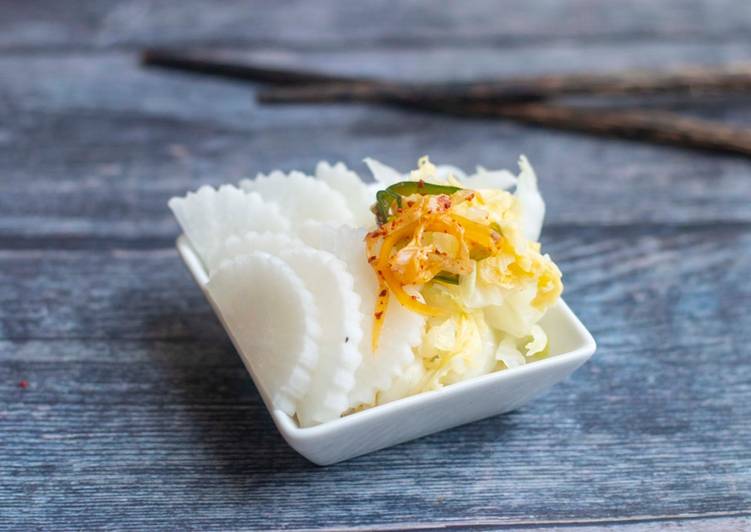Vegetable Pickles or tsukemono. Japanese Pickles or Tsukemono (漬物) are a delicious way to preserve vegetables. Serve them along with a bowl of rice and miso soup for a traditional Japanese breakfast. Tsukemono literally translates to "pickled thing," and it's the Japanese umbrella term for pickles.
 Pickling is a great way to preserve fresh vegetables, and today I'm gonna show you how to make Japanese Pickles, or Tsukemono, three different ways. Tsukemono pickles actually means pickled foods and can refer to a wide assortment of both vegetables and fruits, as well as seaweed. Made using either a salt or vinegar brine or a more involved fermentation process, Japanese pickles, referred to as tsukemono, are comprised of more.
Pickling is a great way to preserve fresh vegetables, and today I'm gonna show you how to make Japanese Pickles, or Tsukemono, three different ways. Tsukemono pickles actually means pickled foods and can refer to a wide assortment of both vegetables and fruits, as well as seaweed. Made using either a salt or vinegar brine or a more involved fermentation process, Japanese pickles, referred to as tsukemono, are comprised of more.
Hello everybody, it's me again, Dan, welcome to my recipe site. Today, I'm gonna show you how to make a distinctive dish, vegetable pickles or tsukemono. One of my favorites. For mine, I'm gonna make it a little bit tasty. This will be really delicious.
Japanese Pickles or Tsukemono (漬物) are a delicious way to preserve vegetables. Serve them along with a bowl of rice and miso soup for a traditional Japanese breakfast. Tsukemono literally translates to "pickled thing," and it's the Japanese umbrella term for pickles.
Vegetable Pickles or tsukemono is one of the most popular of current trending meals on earth. It is simple, it is quick, it tastes delicious. It is enjoyed by millions daily. Vegetable Pickles or tsukemono is something that I have loved my whole life. They are fine and they look wonderful.
To begin with this particular recipe, we have to first prepare a few ingredients. You can cook vegetable pickles or tsukemono using 9 ingredients and 6 steps. Here is how you can achieve that.
The ingredients needed to make Vegetable Pickles or tsukemono:
- {Make ready of Daikon or Mooli.
- {Take of chinese cabbage.
- {Get of Vinegar mixture per 1 vegetable.
- {Make ready of sugar.
- {Prepare of white vinegar.
- {Prepare of lemon.
- {Make ready of warm water.
- {Make ready of sea salt.
- {Prepare of big red chilli (optional).
Tsukemono (漬物), or Japanese pickles, are preserved vegetables that are pickled in salt, salt brine, or rice bran. They come in great varieties and forms Nukazuke also refers to both the pickles and the pickling method. The vegetables are preserved in a brown pungent mash of roasted rice bran (Nuka. Tsukemono (漬物, literally "pickled things") are Japanese preserved vegetables (usually pickled in salt, brine, or a bed of rice bran).
Steps to make Vegetable Pickles or tsukemono:
- Use one daikon. Peel the skin off..
- Cut them into long chunks. Place them in a big container..
- To make pickling marinade. Combine sugar, salt and vinegar until the sugar dissolves. (You can add chilli at this at.
- Add some lemon and mix all..
- Pour the pickling marinade sauce in to the daikon. Cover with lid. Leave it over night at room temperature. Ready to eat after 6 hours or the next day..
- Do the same method with chinese canbage but cut your cabbage vertically..
They are served with rice as an okazu (side dish), with drinks as an otsumami (snack), as an accompaniment to or garnish for meals. Pickled Vegetables - Tsukemono Tsukemono, or Japanese pickled vegetables are a trademark snack or rice accompaniment found in all Japanese I've gotten into pickling lately; Korean pickles, pickled daikon, cucumber pickles and cucumber kimchi (spicy!), enjoying the simplicity and ease of. Japanese pickles (�Е�, tsukemono) are an important part of the Japanese diet. Tsukemono first appeared way back in Japanese history in the days before refrigeration when pickling was All kinds of vegetables and some fruits are used to make tsukemono including, but not limited to, Japanese. In Japan, tsukemono or pickles are used as hashi-yasume, literally "chopstick resters", side dishes that have a totally different texture and flavor.
So that is going to wrap this up for this special food vegetable pickles or tsukemono recipe. Thanks so much for your time. I'm sure that you can make this at home. There's gonna be more interesting food at home recipes coming up. Remember to save this page in your browser, and share it to your family, friends and colleague. Thanks again for reading. Go on get cooking!

0 Comments